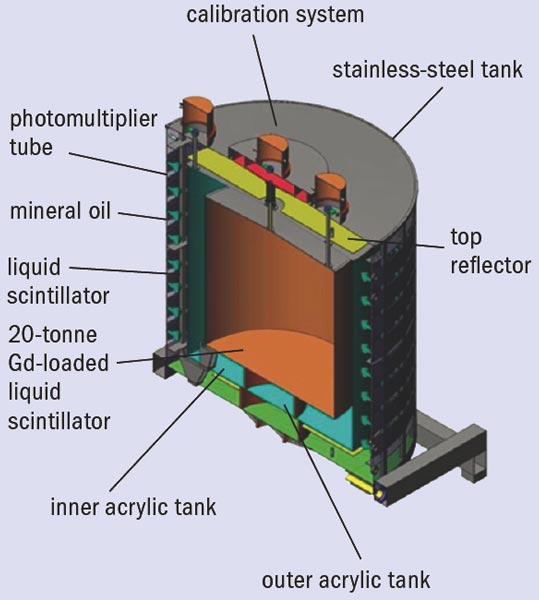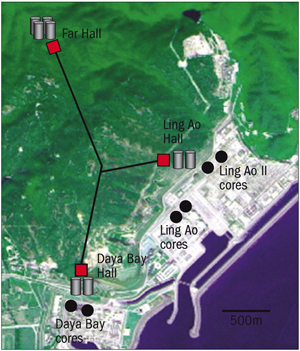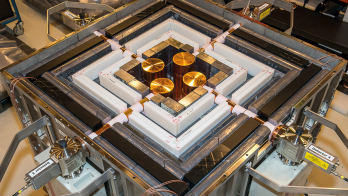On 13 October, members of the Daya Bay Collaboration and government officials from China and the US Department of Energy held a groundbreaking ceremony for the Daya Bay Reactor Neutrino experiment at the Daya Bay Nuclear Power Facility, located in Shenzhen, Guangdong Province, about 55 km north-east of Hong Kong in Southern China. The experiment is poised to investigate the least well known sector of the recently discovered phenomenon of neutrino mixing.

In recent years, several experiments have discovered that the three flavours of neutrino can oscillate among themselves – a result of the mixing of mass eigenstates. Among the three mixing angles required to describe the oscillation, θ13 is the least well known. Besides determining the amount of mixing between the electron-neutrino and the third mass eigenstate, θ13 is a gateway to the future study of CP violation in neutrino oscillation.
To date, the best limit on θ13 is sin22θ13 < 0.17, reported by the CHOOZ reactor neutrino experiment using one detector on a baseline of 1.05 km. However, the current understanding of neutrino oscillation indicates that the disappearance of reactor antineutrinos at a distance of about 2 km would provide an unambiguous determination of θ13. This is the goal of a new generation of reactor neutrino experiments utilizing at least two detectors at different baselines. Such a near–far configuration eliminates most of the reactor-related systematic errors and some of the detector-related systematic uncertainties.

Image credit: Daya Bay Collaboration.
The Daya Bay experiment should discover neutrino oscillation due to θ13 mixing and measure sin22θ13 to an unprecedented sensitivity of better than 0.01 at 90% CL – an order of magnitude better than the present limits. The experiment will look for electron antineutrinos from the reactors via the inverse beta-decay reaction in a gadolinium-doped liquid scintillator target (figure 1). In the reaction, an electron-antineutrino interacts with a proton (hydrogen in the scintillator), producing a positron and a neutron. The energy of the antineutrino is determined by measuring the energy loss of the positron in the scintillator. The collaboration will extract the value of sin22θ13 by comparing the fluxes and energy distributions of the observed antineutrino events in the near and the far halls (figure 2).
The ceremony on 13 October marks the beginning of civil construction near the Daya Bay and Ling Ao reactors, the sources of the electron-antineutrinos for the experiment. When the Ling Ao II nuclear power plant is commissioned by 2011, the three pairs of reactors will be one of the most powerful nuclear-energy facilities in the world. Three underground experimental halls connected by long tunnels will be excavated in the nearby mountains, which will shield the experiment from cosmic rays. In each hall, the antineutrino detectors (two in each near hall and four in the far site) will be deployed in a water pool to protect the detectors from ambient radiation. Together with resistive plate chambers above, the water pool also serves as a segmented Cherenkov counter for identifying cosmic-ray muons.
The project is now ready to begin manufacturing and mass production of the detector components. The first experimental hall is scheduled to be ready by the end of 2008. Commissioning of the detectors in this hall will take place in 2009. Construction will continue for about two years, with installation of the last detector scheduled for 2010.
• The Daya Bay Collaboration consists of 35 institutions with more than 190 collaborators from three continents. The project is supported by the funding agencies in China and the US, and is one of the largest co-operative scientific projects between the two countries. Additional funding is being provided by the other countries and regions, including Hong Kong, Taiwan, the Czech Republic and Russia.







